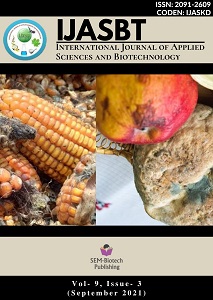Mycotoxins in Foods: Occurrence, Challenges and Management in Context of Nepal
DOI:
https://doi.org/10.3126/ijasbt.v9i3.38758Keywords:
Aflatoxins, Consumer, Contamination, Food Safety, Mycotoxins, RegulationsAbstract
Incidence of mycotoxins in principal foods and grains is a major threat to achieving food safety but still remains one of the most underrated and ignored sources for food borne diseases, particularly in less developed countries. Furthermore, food insecurity together with ineffective government regulations and environmental conditions that favor fungal proliferation and toxin production merge together to make the people’s life even harder in countries like Nepal. Apart from wasting huge quantities of food every year, mycotoxins are associated with various acute and chronic health disorders including carcinogenic, mutagenic, estrogenic, digestive, vascular and nervous defects. Staple diets in less developed countries like Nepal are largely based on crops like maize, susceptible to mycotoxins which may ultimately lead to chronic health problems in large population. Although there is an immediate need to address the food safety challenges caused by mycotoxin contamination in cereal grains, studies so far in Nepal has been conducted mainly in aflatoxins in limited commodities only and very less efforts have been made to manage and mitigate the problems caused by mycotoxins in Nepal. Therefore, a thorough control of mycotoxins in overall food chain is essential to safeguard the health of the population which could be achieved by implementing stricter regulations, modern and scientific post-harvest operations, effective monitoring programs and raising necessary awareness among stakeholders.
Int. J. Appl. Sci. Biotechnol. Vol 9(3): 152-159.
Downloads
Downloads
Published
How to Cite
Issue
Section
License
Copyright (c) 2021 International Journal of Applied Sciences and Biotechnology

This work is licensed under a Creative Commons Attribution-NonCommercial 4.0 International License.




